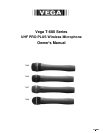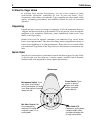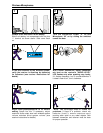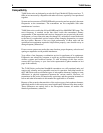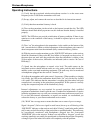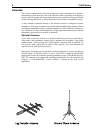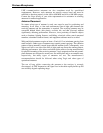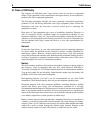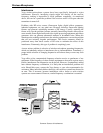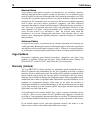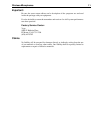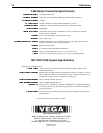
In Case of Difficulty
The majority of difficulties with Vega wireless mics are not due to equipment
failure. Vega equipment is fully tested before leaving the factory. In most instances,
problems are due to equipment application.
The following paragraphs describe the most commonly encountered application
problems. If you are having difficulties with Vega equipment, please review this
information and take any necessary corrective action prior to returning the
equipment for repair.
Most users of Vega equipment enjoy years of troublefree operation. However, as
with all electronic devices, problems might be encountered eventually. If you
experience difficulty with your Vega wireless microphone within the first year of
operation, it will be repaired under warranty (see below). Service for older units may
also be obtained from Vega; contact the factory or your sales representative for
information.
General
Contact the Vega factory or your sales representative prior to returning equipment
for repair. Often, the problem can be resolved by phone, avoiding downtime for
unnecessary returns. However, should repairs be necessary, Vega will promptly
correct the problem and return the unit. Return both the transmitter and the receiver,
to allow us to perform a complete checkout and test of the entire system. This can be
especially helpful for elusive or intermittent problems
Battery
The most common problems with wireless-microphone systems are those related to
the batteries. Vega recommends that only new, fresh Duracell MN1604 or
“Eveready” Energizer No. 522 alkaline batteries be used. No other batteries tested by
Vega provide equal life and reliability. Other batteries might work, but battery life
probably will be short and current inadequate.
Rechargeable batteries (“ni-cads”) are not recommended for use with T-680
transmitters. Their limited capacity does not provide adequate operating time.
Exhausted batteries will cause numerous problems, including distortion, audible
squeals and howls, poor range, and off-frequency operation. It is strongly
recommended that the battery be checked prior to each use, and that it be replaced if
there is any question about its condition. It is also good practice to try replacing the
battery with a fresh unit in the event of any sort of problem with the system, because
a low battery might affect system operation in subtle ways.
Battery contacts must be clean and unbroken. Attempted forced reverse insertion of
a battery is practically impossible, but the attempt will often damage the battery
contacts. Some “9-volt” batteries sold are larger (or smaller) than standard and either
might fail to work or might damage the contacts when inserted. Damage to the
contacts usually requires a return to the factory or authorized service center.
8 T-680 Series



